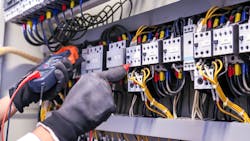Terminal blocks are common in the industrial electrical control panels of nearly every automation system. There are several different types and uses, depending upon the application.
Terminal blocks are utilized because of their durability in industrial environments and for their safety to the end user inside of the industrial control panel. The component has an insulated frame purpose-made to securely join two or more wires together in an organized and safe manner.
While it is possible to join wires together using solder, tape, wire nuts and other means, using terminal blocks gives us the option to be able to put wires in an organized place with the ability to install and remove wires as needed for maintenance, troubleshooting and inspection purposes. Modification and identification of terminal-block wires are simple and quick when properly labeled.
Also read: 7 stages of terminal-block implementation
As each individual type of terminal block serves a different application or functionality, some of the most common terminal-block types can be compared in terms of usefulness and purpose. Depending upon their characteristics, such as structure, device type or termination options, there are different classifications of terminal blocks.
The single-level terminal block is one of the most basic. It allows clean connection between wires for basic functions inside the control panel. Single-level terminal blocks are also used as ground connectors for several wires to connect the ground using the same block and are color-coded accordingly.
Single-level terminal blocks can also be fused. The fuse adds another layer of safety at the terminal block and often has a light-emitting diode (LED) attached as an indicator of the condition of the fuse.
Multi-level terminal blocks are often used in cases where instrumentation in the automation system needs feedback and information to be returned to the control. Typically, one wire will go out to the instrument being used and another wire will come back from the instrument into the multi-level terminal block. This is a better use of the available space inside the control panel as space tends to be limited.
Also read: Push-in terminal block technology dominates
Multiple instruments then can be attached and connected through multi-level terminal blocks. These are also able to be fused and oftentimes are preferred over non-fused terminal blocks because that adds a layer of control to an individual instrument that can be disconnected at will.
Terminal blocks have several different styles of connectors. It is not uncommon to have a single manufacturer of terminal blocks that offers a wide variety of connection styles in its product lineup. This added flexibility is an advantage to control-panel designers as they are creating new designs, giving them options to meet the needs of the application.
By far the most common and possibly oldest style of terminal block connection is the screw-type connection. All that is needed is a stripped wire and a precision screwdriver. The stripped wire is inserted into the terminal block opening and the screw is tightened to securely fasten the wire. However, one of the disadvantages of screw-type connectors is they can be overtightened very easily, which results in a poor connection and possibly an unsafe condition.
Manufacturers offer other connecting styles such as the spring-cage terminal blocks. A precision screwdriver is used to open this spring cage and the wire is inserted and securely held once the screwdriver is removed. This prevents overtightening, and it’s a safe and secure connection.
Also read: Terminal blocks and I/O go digital
Many operators prefer a push-in-terminal (PIT) type of connection as they are tool-free. PIT connections do require a ferrule to be added to the stripped wire but can be quickly and easily connected and disconnected as needed.
Certain applications require a gas-seal connection to prevent any breakdown or corrosion of the wire. Often in cases like this we will see operators use a quick-connect terminal block that does not require stripping as the terminal block can penetrate the shielded wire and make the connection.
In cases where vibration is a concern, we will often see a barrier terminal block utilized. A barrier terminal block allows us to use a ring or spade terminal at the end of our wire, which allows us to make a connection that is antivibration as it will have a spade terminal clamped tightly with a nut and bolt within the terminal-block housing.
In general, terminal blocks are connected to a DIN rail within the industrial control panel. These are standard throughout the industry and are the backbone of any control-panel assembly.
Think of terminal blocks as industrial wire nuts that operate in a safe, secure and organized manner to facilitate the distribution of power throughout industrial control panel. The wide variety of terminal blocks available gives us much-needed flexibility. Additionally, terminal blocks prevent potentially dangerous conditions in cases where incorrectly made connections could allow for loose or sloppy wiring to exist.
Also read: Screw clamp or IDC terminal connectors: which works better?
About the Author
Andy Watkins
Contributing Editor
Andy Watkins is direct sales manager at Romi Machine Tools in Erlanger, Kentucky. Contact him at [email protected].

Leaders relevant to this article:

